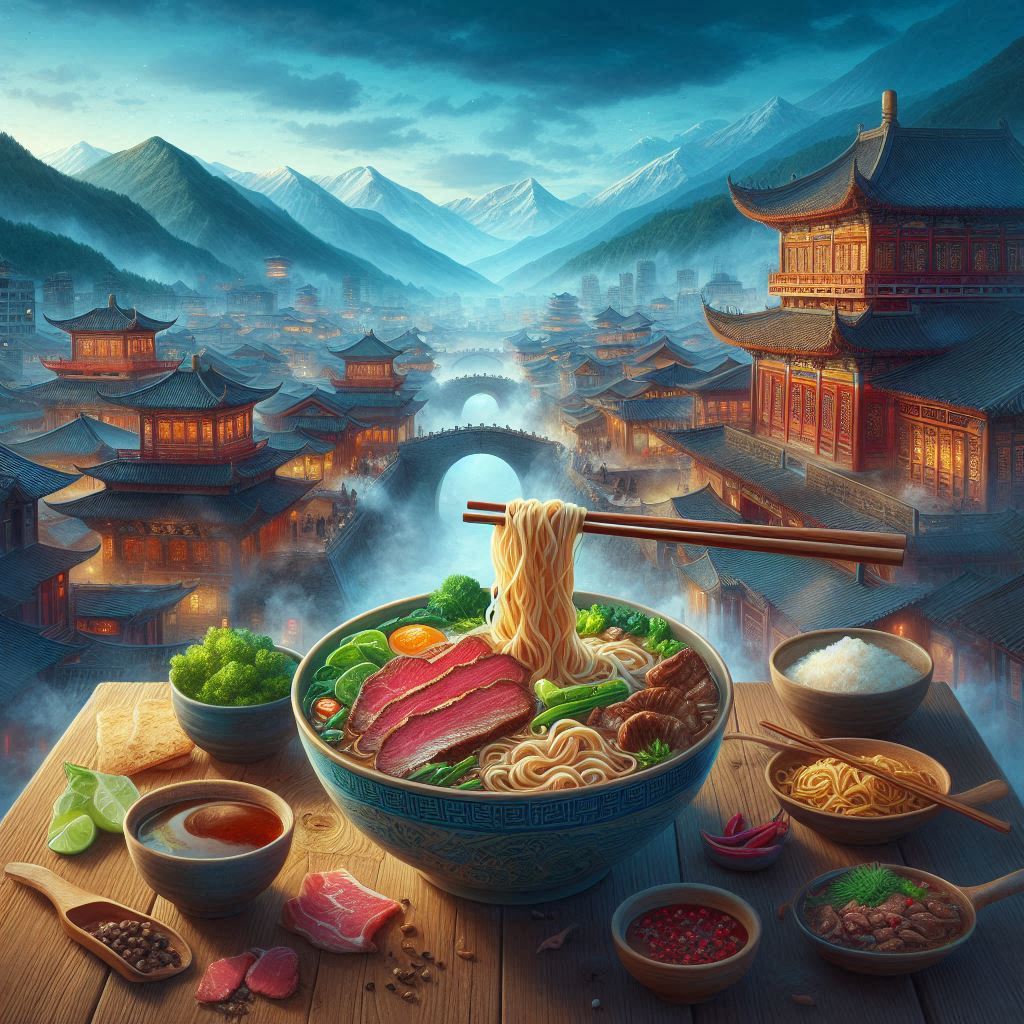蘭州拉麵的作法
蘭州拉麵,又稱蘭州牛肉麵,是中國西北地區著名的麵食之一,起源於甘肅省蘭州市。這道麵食以其獨特的手工拉麵技藝、清爽的湯頭和香嫩的牛肉片而聞名於世。在中國各地的餐館中隨處可見,並且因其深厚的文化底蘊和極佳的口感,成為許多食客的最愛。
湯頭具有“清、白、紅、綠、黃”的五大特色,這五個要素分別指代湯頭的清澈、白蘿蔔片的白、辣椒油的紅、香菜與蒜苗的綠以及麵條的黃。湯頭通常以牛骨長時間熬煮,加入多種香料如草果、丁香、桂皮、當歸等,經過數小時的熬製,湯味濃郁但不油膩,散發著淡淡的藥香。
麵條製作過程極具特色,講究手工拉制技藝。拉麵師傅首先將麵團經過反覆揉製,讓麵粉的麵筋充分發展,這樣麵條才會具有彈性。然後,師傅會將麵團切成劑子,根據需要將其拉成不同的麵條粗細,比如毛細、二細、三細、韭葉、寬麵等不同類型。拉麵的過程是將劑子在兩手之間來回拉扯,讓麵條逐漸拉長,並不斷抻拉,直到形成均勻細長的麵條。這一過程需要高度的熟練技巧和速度,否則麵條容易拉斷或者厚薄不均。
當麵條製作完成後,師傅會將麵條快速下入沸水中煮熟,煮麵的時間非常短,通常只需幾十秒到一分鐘,這樣可以保證麵條保持彈性與滑嫩的口感。麵條煮好後,迅速撈出放入事先準備好的牛骨清湯中,然後加入切薄的牛肉片、煮熟的白蘿蔔片、香菜、蒜苗和一勺紅亮的辣椒油。這些配料不僅增加味道的層次感,也使蘭州拉麵在視覺上具有豐富的色彩對比。
主要的精髓在於其簡單而獨特的配料搭配,這道麵食不依賴過多的調味料,而是通過每一個細節的精確處理,展現出食材的自然味道。清澈的湯頭、彈牙的麵條、嫩滑的牛肉片與爽口的白蘿蔔,形成口感豐富的層次。這道傳統麵食有著悠久的歷史,據說可以追溯到唐朝時期,後來在清朝嘉慶年間由河南傳入蘭州,經過回教師傅的進一步發良。如今,已成為中國十大麵食的重要代表之一,並且隨著移民和文化的傳播,也開始在世界各地流行,成為國際熟知的中國傳統美食。
總的來說,蘭州拉麵是手工技藝和精緻飲食文化的結合體。它不僅僅是一碗麵,更是歷史與地域特色的體現,代表蘭州地區的飲食精髓。製作過程注重每一個細節,從湯頭到麵條,再到配料,無不體現出中國傳統烹飪的精妙與用心。
Lanzhou Lamian, also known as Lanzhou Beef Noodles, is one of the most famous noodle dishes from northwest China, originating in Lanzhou, Gansu Province. This dish is renowned for its unique hand-pulled noodle technique, refreshing broth, and tender slices of beef. Found in restaurants all across China, Lanzhou Lamian has become a favorite among diners due to its deep cultural roots and exceptional taste.
The broth of Lanzhou Lamian is characterized by five distinct features: "clear, white, red, green, and yellow." These elements refer to the clarity of the broth, the whiteness of the radish slices, the redness of the chili oil, the green of cilantro and scallions, and the yellow of the noodles. The broth is typically made by simmering beef bones for a long period of time, infused with various spices such as tsao-ko, cloves, cinnamon, and angelica root. After several hours of cooking, the broth develops a rich yet light flavor with a delicate herbal fragrance.
The noodle-making process is highly distinctive, emphasizing the art of hand-pulling. The noodle maker first kneads the dough repeatedly to fully develop the gluten, ensuring the noodles are elastic. The dough is then divided into smaller portions, which are pulled into different thicknesses of noodles depending on the desired type—such as hair-thin, fine, medium, flat, or wide noodles. The process of pulling the noodles involves stretching the dough between both hands, gradually lengthening the noodles while continuously pulling and stretching until thin and even strands are formed. This technique requires a high level of skill and speed, as the noodles can easily break or become uneven in thickness.
Once the noodles are prepared, they are quickly cooked by dropping them into boiling water. The cooking time is very short, usually only lasting from a few seconds to a minute, ensuring the noodles maintain their elasticity and smooth texture. After cooking, the noodles are swiftly removed and placed into a pre-prepared beef broth. Thin slices of beef, cooked radish, cilantro, scallions, and a spoonful of bright red chili oil are then added on top. These toppings not only enhance the flavor but also create a vibrant contrast of colors, making the dish visually appealing.
The essence of Lanzhou Lamian lies in its simple yet unique combination of ingredients. The dish does not rely on an abundance of seasoning but instead highlights the natural flavors of the ingredients through precise preparation. The clear broth, chewy noodles, tender beef slices, and crisp radish create a rich and layered taste experience.
This traditional noodle dish has a long history, said to trace back to the Tang Dynasty. It was later introduced to Lanzhou during the Jiaqing period of the Qing Dynasty by chefs from Henan and further refined by Muslim masters in the region. Today, Lanzhou Lamian has become one of China's top ten iconic noodle dishes. As Chinese immigrants and culture spread around the world, Lanzhou Lamian has also gained international popularity, becoming a well-known traditional Chinese delicacy worldwide.
In summary, Lanzhou Lamian is a combination of artisanal craftsmanship and refined culinary culture. It is not just a bowl of noodles but also a reflection of history and regional characteristics, representing the culinary essence of the Lanzhou region. The meticulous preparation process, from the broth to the noodles and toppings, showcases the skill and care embedded in traditional Chinese cooking.




照片:DALLE3
- 1
- 2
- 3
- 4
